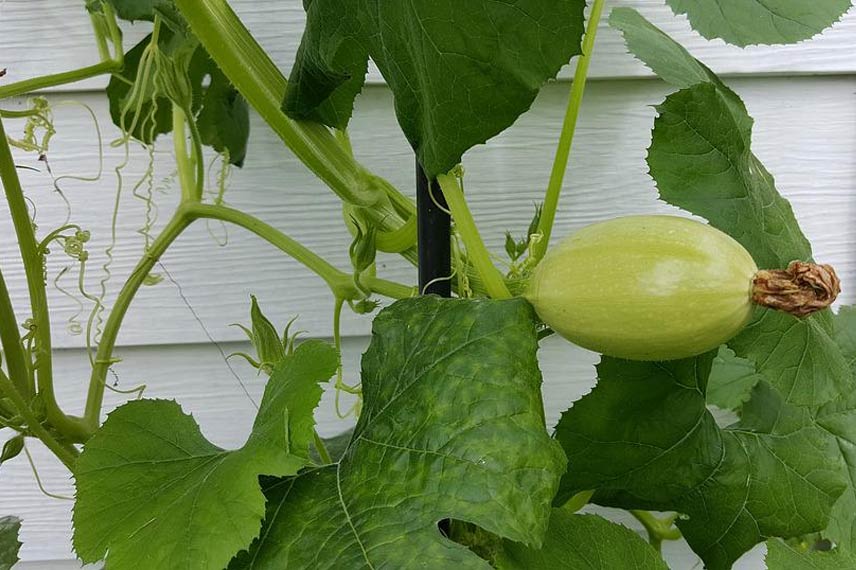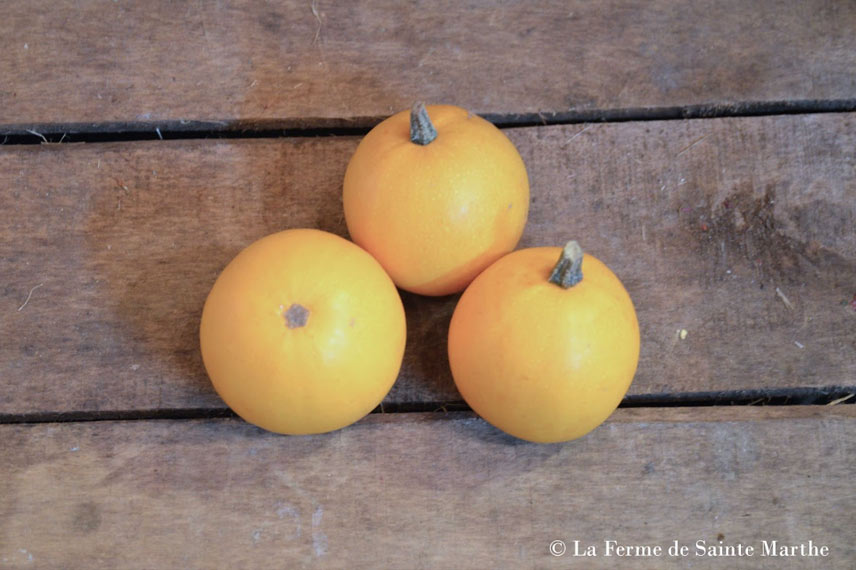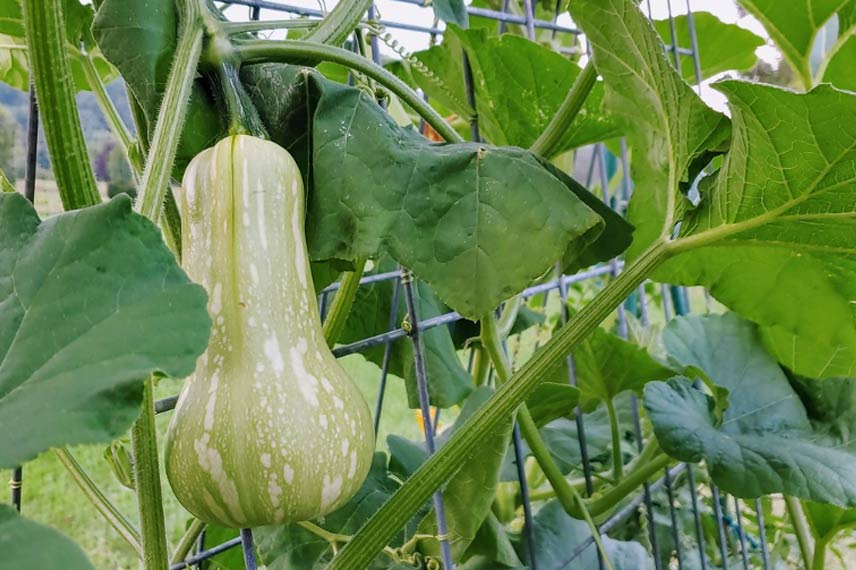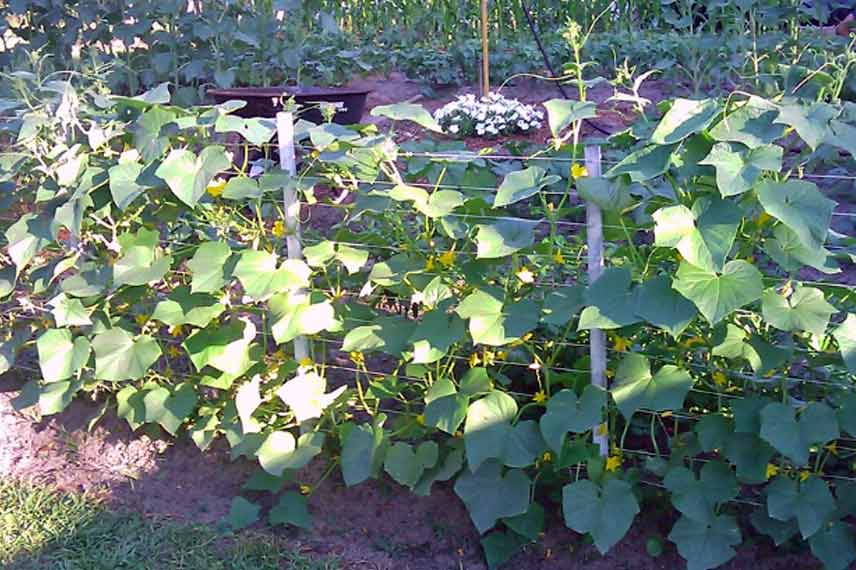Squashes and courgettes belong to the cucurbit family, a group of generally herbaceous plants with a creeping or climbing habit, and stems sometimes equipped with tendrils. As such, cucurbits require plenty of space to spread their extensive branching. In a small garden, don't hesitate to train them vertically to save space.
Possible varieties, supports to use, techniques... Here's how to train squashes vertically.
Why train squashes vertically?
Vertical cultivation has certain advantages, particularly when garden space is limited. Thus, training squashes vertically allows you to save considerable space. While it's generally recommended to space squash plants 2m apart, vertical cultivation reduces this gap to 1m, or even 0.5m.

Climbing spaghetti squashes
Moreover, this method of cultivation prevents the fruits from being in constant contact with the soil, improving air circulation between the leaves of your cucurbits and limiting disease risks (mildew, bacterial wilt, scorch). Not to mention that while harvesting becomes much more comfortable for you, it's much harder for small animals to eat your squashes.
Finally, vertical cultivation limits the appearance of spots and fruit yellowing, phenomena very common with ground-level cultivation.
Which squash varieties are suitable for vertical training?
Among cucurbits best suited to vertical training, we think of trailing varieties with tendrils. Additionally, fruit size and weight are crucial here. Abandon the idea of growing the largest squashes vertically. Varieties producing fruits over 4kg are indeed much better suited to ground-level cultivation!

'Pomme d’or' squashes
However, there are many varieties of small squashes perfect for vertical training, such as:
- the 'Baby Boo', a trailing variety with tendrils producing mini fruits of 100-300g, 5-8cm in diameter;
- the 'Pomarine', a productive trailing variety yielding fruits averaging 300g, 5-8cm in diameter;
- the 'Sweet dumpling', a trailing variety producing fruits of about 500g, 8-15cm in diameter;
- the 'Pomme d’or', a productive trailing variety yielding fruits of 50-200g, 6-8cm in diameter.
Unlike their squash cousins, courgettes generally don't have tendrils to help them climb. However, they can also be trained against a support. We particularly think of:
- the 'Shooting star', a productive variety with long fruits harvested when they reach 15-20cm;
- the 'Zéphyr', a bicolour variety with long, narrow fruits harvested at 10-16cm;
- or the 'Black Forest', a trailing variety with vigorous growth and elongated, very tasty fruits.
What support should you use to train squashes vertically?
Galvanised sheep fencing, masonry trellis, welded wire mesh rolls, rigid panel fencing... The most important thing here is to use a support strong enough to bear the weight of the squashes.

Butternut squashes on masonry trellis ©sk - Flickr
Sheep fencing can, for example, be installed along each row of squashes:
- plant stakes at the base of your plants;
- stretch the sheep fencing vertically between these stakes;
- train your squashes to climb this support.
You can also let your squashes run vertically along a wall or low wall:
- attach the fencing to the wall using wall fixings for fencing and rigid panels;
- or fix sturdy shelf brackets before attaching your fencing.
It's also possible to build an arbour:
- use hazel branches;
- construct a teepee-shaped arbour;
- cover the structure with sheep fencing.
Note: trees and informal hedges also work perfectly as supports for climbing cucurbits.
How to train squashes vertically
Materials needed:
- a training support (see above);
- jute twine.
The technique
- In spring, enrich the soil abundantly with compost and install your squash support.
- Around mid-May, transplant your young squash and courgette plants into open ground.
- Choose a sunny spot at the base of the training support.
- When the squashes reach about 20cm, insert the lianas gently into the trellis supports (the tendrils will soon take over).
- Tie the lianas to their support with soft ties, like jute twine, kept loose enough not to damage the plant.
- Repeat the process as growth continues, ensuring stems are well spaced to allow air and light to penetrate beneath the leaves.

Vertically trained cucurbits in the vegetable garden ©Sharib4rd - Flickr
Warning: take care that your cucurbit fruits don't develop in the gaps of their training support.
Maintenance
- Regularly check the growth of your vertically trained squashes and adjust ties as needed.
- Ensure you water very regularly, as vertically trained squashes tend to dry out much faster.
- Apply a thick layer of organic mulch at the base to retain soil moisture longer. As it decomposes, the mulch will also nourish the soil.
- In small spaces, it's important to prune your squash plants:
- when the main stem has 4-5 leaves, cut it back to 2 leaves;
- after 3 weeks, when secondary stems have developed 8 leaves, cut them back to 5 leaves;
- once fruits have formed, cut back to 2 leaves.
For more information, see all of Aurélien's advice on how to sow, plant, grow and harvest your squashes.



































Comments